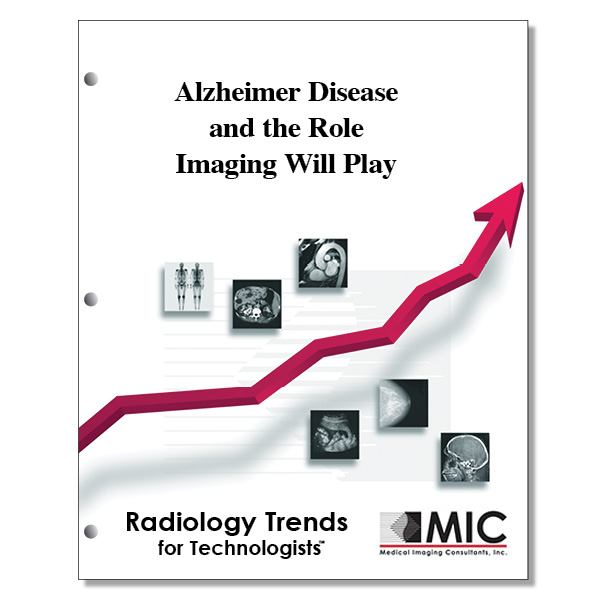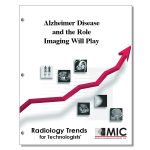

Alzheimer Disease and the Role Imaging Will Play
A review of Alzheimer Disease, biomarkers, new diagnostic criteria, and a call for standardization of imaging.
Course ID: Q00376 Category: Radiology Trends for Technologists Modalities: MRI, Nuclear Medicine, PET3.25 |
Satisfaction Guarantee |
$34.00
- Targeted CE
- Outline
- Objectives
Targeted CE per ARRT’s Discipline, Category, and Subcategory classification:
[Note: Discipline-specific Targeted CE credits may be less than the total Category A credits approved for this course.]
Magnetic Resonance Imaging: 2.25
Patient Care: 1.00
Patient Interactions and Management: 1.00
Procedures: 1.25
Neurological: 1.25
Nuclear Medicine Technology: 3.25
Patient Care: 1.00
Patient Interactions and Management: 1.00
Procedures: 2.25
Other Imaging Procedures: 2.25
Radiography: 1.00
Patient Care: 1.00
Patient Interactions and Management: 1.00
Registered Radiologist Assistant: 3.25
Procedures: 3.25
Neurological, Vascular, and Lymphatic Sections: 3.25
Sonography: 1.00
Patient Care: 1.00
Patient Interactions and Management: 1.00
Outline
- Introduction
- Demographics and Public Health Impact
- Clinical Course of the Disease
- Genetics and Molecular Pathways: The Amyloid Cascade Hypothesis
- Pathologic Features and Their Relationship to Clinical Symptoms
- AD Biomarkers
- Temporal Ordering of AD Biomarkers
- Modifiers of Clinical Expression: Cognitive Reserve and Genetics
- Modifiers of Clinical Expression: Coexistent Age-related Brain Abnormality
- Diffusion, Perfusion, Spectroscopy, and Functional MR Imaging
- Diffusion Imaging
- Perfusion Imaging
- Hydrogen 1 MR Spectroscopy
- Functional MR Imaging
- Applications of Imaging Biomarkers: New Diagnostic Criteria for AD
- Applications of Imaging Biomarkers: Clinical Trials
- Subject Inclusion
- Subject Exclusion
- Stratification, Enrichment, and Covariates
- Outcome
- Need for Standardization of Imaging
Objectives
Upon completion of this course, students will:
- identify the features of Alzheimer disease that make it an unprecedented public health problem
- understand the definition of dementia
- identify the age group at increased risk for death from Alzheimer disease
- understand the annual rate of conversion from mild cognitive impairment to Alzheimer disease
- identify the percentage of individuals that will convert to dementia after a diagnosis of MCI
- recognize the genetic risk factors for Alzheimer disease
- understand the function of the apolipoprotein E gene in cholesterol metabolism
- recognize the negative effects from the presence of the APOE ε4 allele
- recognize the positive effect from the presence of the APOE ε2 allele
- understand the role of Aβ in familial Alzheimer disease
- understand the role of Aβ in late onset sporadic Alzheimer disease
- identify Aβ as the target of the majority of clinical trials on disease modification
- identify the neuritic plaque as the hallmark Aβ peptide deposit in Alzheimer disease
- understand the use of the term “biomarker” in Alzheimer disease investigation
- understand the role of cerebrospinal fluid analytes in Alzheimer disease investigation
- understand the correlation between a clinical diagnosis of Alzheimer disease and amyloid imaging studies
- recognize the physiologic features that are associated with greater amyloid PET binding in cognitively normal late-middle-aged to elderly subject
- recognize the neurologic conditions that may exhibit elevated levels of tau in CSF
- identify the typical uptake pattern on FDG PET imaging that is consistent with Alzheimer disease
- identify the physical half-life of the oxygen-15 isotope used in PET imaging
- recognize the various PET imaging agents used to image Aβ accumulation in the brain
- identify the imaging features of the PET imaging agent 18F-FDDNP
- understand the link between cognitive impairment and neurodegeneration
- understand the term “cognitive reserve” and its application
- recognize the comorbid brain pathologic conditions that are most commonly found at autopsy in elderly subjects with a diagnosis of Alzheimer disease
- identify cardiovascular disease as the second most common pathologic contributor to dementia in elderly persons after Alzheimer disease
- identify microinfarction as the most common vascular lesion found in community autopsy studies
- recognize the brain regions that exhibit characteristic decreased blood flow on perfusion imaging in the presence of Alzheimer disease
- identify the imaging techniques currently being used to assess cerebral blood flow in the presence of Alzheimer disease
- recognize the metabolites that are consistently abnormal in hydrogen-1 MR spectroscopy in the presence of Alzheimer disease
- understand the use of hydrogen-1 as the isotope target of MR imaging and spectroscopy
- identify the compounds that are not detectable by hydrogen-1 MR spectroscopy
- compare the techniques currently being used to acquire perfusion images in the presence of Alzheimer disease
- identify the three currently recognized phases of Alzheimer disease
- understand the role of anatomic MR imaging for exclusionary purposes in Alzheimer disease therapeutic trials
- recognize the target of current available treatments for Alzheimer disease
- understand the coverage criteria established by CMS for FDG PET imaging of Alzheimer disease
- identify other diseases that cause dementia that must be included in the differential diagnosis with Alzheimer disease
- identify the imaging requirements that must be satisfied for CMS coverage of FDG PET imaging of Alzheimer disease
- understand the coverage criteria established by CMS for Aβ PET imaging of Alzheimer disease
